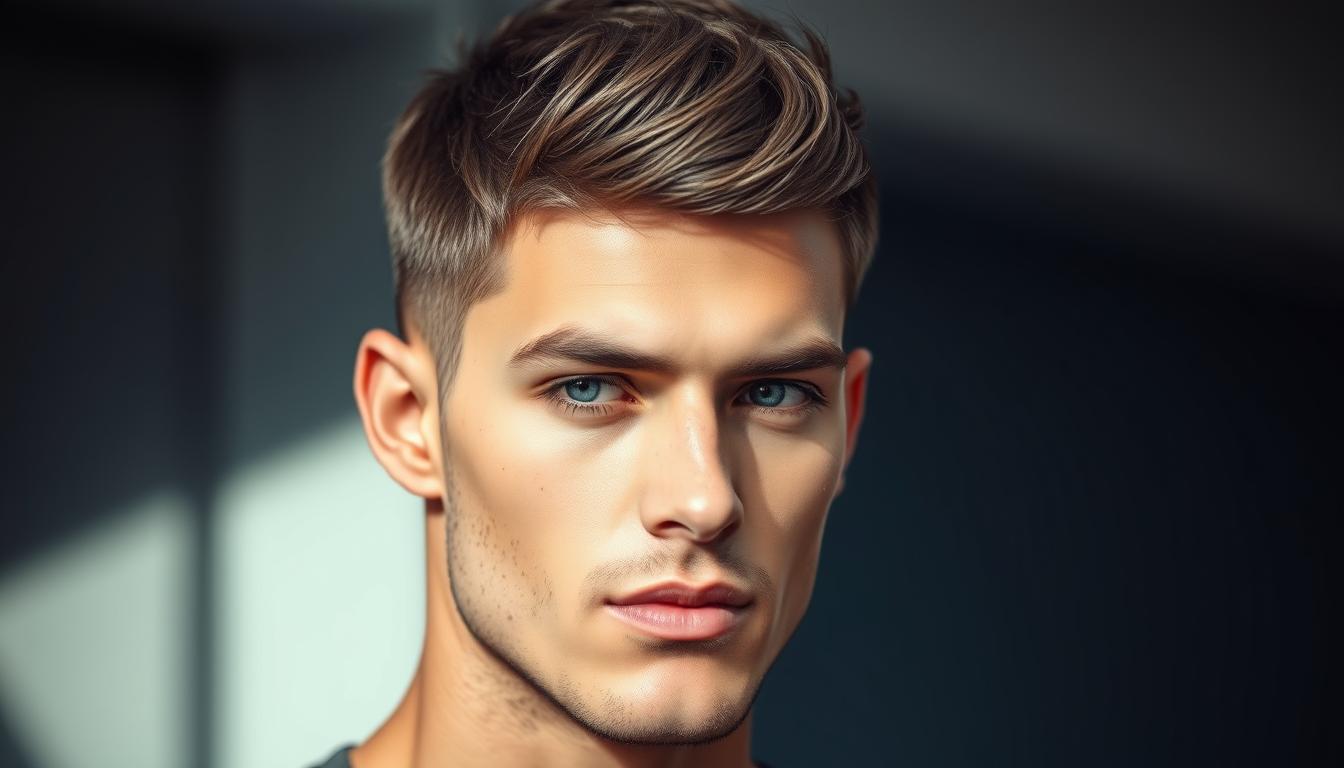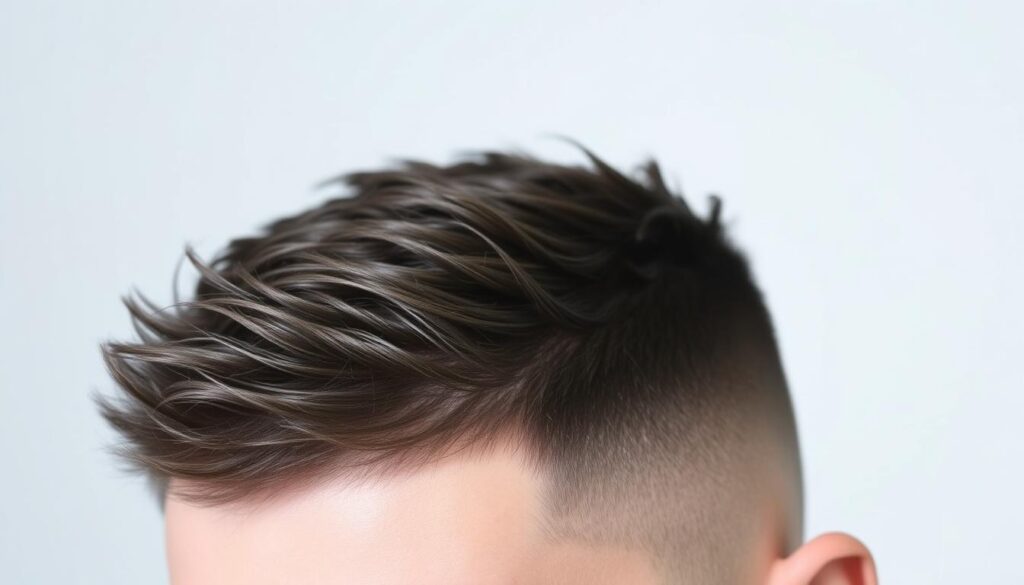
What if your current hairstyle is holding you back from looking your best? The right cut can elevate your confidence, streamline your routine, and adapt to any occasion. For men seeking a polished yet adaptable look, there’s one style that’s dominating the grooming scene—and it’s not what you might expect.
The crew cut isn’t just a relic of military fashion. Modern versions blend sharp lines with natural texture, creating a balance between professionalism and ease. With tapered sides and a slightly longer top, this cut works for thick, wavy, or straight hair. It’s versatile enough for the office yet relaxed for weekends.
Why has this style become a top choice? Unlike ultra-short buzz cuts, the crew cut offers styling flexibility. You can tousle it for a casual vibe or keep it sleek for formal events. Plus, it requires minimal upkeep—perfect for busy schedules.
Key Takeaways
- Adaptable for most face shapes and hair types, including thick or wavy textures
- Combines classic structure with modern texture techniques for a relaxed finish
- Top length ranges from ½ to 2 inches for personalized styling options
- Faded sides and back create contrast, emphasizing the textured top
- Ideal for men prioritizing low-maintenance grooming without sacrificing style
Introduction to the Crew Cut Tradition

Before becoming a modern staple, this hairstyle served athletes and soldiers. Its journey from functional necessity to style icon reveals why it remains relevant today.
Brief History and Origins
The traditional crew cut began with 1920s Ivy League rowers. Teams needed {{the}}, wind-resistant styles for competitions. Rowers called it the “boatman’s cut” before the term “crew” stuck.
Military forces later adopted the look during WWI. Soldiers appreciated its low maintenance and clean appearance. By WWII, it symbolized discipline and practicality across branches.
Evolution of the Crew Cut Look
Post-war America transformed the style into a collegiate status symbol. Ivy League campuses like Yale popularized tapered sides with slightly longer tops. This “preppy” version balanced athletic roots with sophistication.
| Era | Key Development | Cultural Impact |
|---|---|---|
| 1920s | Rowing team adoption | Practical athletic solution |
| 1940s | Military standardization | Symbol of duty and order |
| 1950s | Ivy League refinement | Marker of educated elite |
Today’s versions keep the original structure while adding texture. Modern styling products let men personalize length and finish. The core principles – simplicity and adaptability – remain unchanged.
Understanding the Textured Crew Cut

Your hairstyle shouldn’t limit your look—it should enhance it. This modern take on a classic design combines structure with adaptability, perfect for those wanting both polish and personality.
Key Features and Benefits
This style thrives on contrast. Faded sides create sharp edges, while the 1-2 inch top adds dimension. Natural waves or thick hair types benefit most, as they amplify the lived-in aesthetic.
| Feature | Classic Crew Cut | Textured Version |
|---|---|---|
| Top Length | ½ inch | 1-2 inches |
| Styling Time | 2 minutes | 3-5 minutes |
| Best For | Straight hair | Wavy/thick hair |
Use products like GATSBY Inside Lock Natural Lift to define separation. A dime-sized amount gives hold without stiffness. Rake through damp hair, then scrunch for natural lift.
The real advantage? It looks intentional yet stylish. Keep it neat for client meetings or mess it up before weekend plans. With monthly trims and daily product use, you’ll maintain sharp lines with minimal effort.
Choosing the Right Crew Cut Style for Your Face
Your face structure determines which hairstyle enhances your best features. The right choice creates balance while highlighting your natural angles and curves. Let’s break down how to match your unique proportions with modern styling options.
Face Shape Considerations
Not all styles work equally for every silhouette. Oval faces handle most lengths well, from short sides to slightly longer tops. Square jaws benefit from textured tops that soften sharp angles.
| Face Shape | Recommended Style | Key Benefit |
|---|---|---|
| Oval | Classic crew cut | Maintains natural symmetry |
| Square | Modern textured top | Softens jawline |
| Round | High-taper fade | Adds vertical emphasis |
| Rectangular | Fuller top + tight sides | Balances length |
Personalizing Your Look
Your hairline and jaw strength matter more than you think. Thick hair? Keep the top under 1.5 inches. Fine strands? Add texture with matte paste for visual volume.
“The goal isn’t to fight your natural shape—it’s to work with it. A good barber will adjust clipper lengths based on your crown’s growth pattern.”
Asian hair types often suit tighter fades, while wavy Western hair shines with messy texture. Use a boar bristle brush to train cowlicks during styling. Remember: monthly trims keep your shape looking intentional.
Essential Tools and Products for Styling
Mastering your hairstyle starts with the right arsenal. The difference between a basic trim and a standout look lies in your product choices and application techniques. Let’s break down the essentials for creating lasting definition and effortless appeal.
Recommended Hair Products
Texture begins with the right formulas. GATSBY Inside Lock Natural Lift adds tousled separation to shorter tops, while their Moving Rubber Spiky Edge keeps spikes intact for bold statements. For sleek side parts, Dressing Pomade Classical Tight delivers a polished finish that lasts all day.
Sea salt spray is a game-changer for adding grit and volume. Spritz it on damp strands before blow-drying to create natural-looking separation. Matte clays work well for thicker hair, offering flexible hold without shine.
Tool Guide for Perfect Hold
Your toolkit matters as much as your products. A fine-tooth comb ensures clean part lines, while a vent brush helps distribute heat evenly during blowouts. For quick touch-ups, a compact mirror keeps edges sharp on the go.
| Tool | Purpose | Best For |
|---|---|---|
| Boar Bristle Brush | Smoothing & Shine | Fine to Medium Hair |
| Ceramic Blow Dryer | Volume Building | All Hair Types |
| Matte Paste | Natural Texture | Thick or Wavy Hair |
Pair these with a lightweight pre-styler like heat protectant spray. It shields strands while creating a base for stronger hold. Remember: less product often yields better results—start with a dime-sized amount and build as needed.
Communicating with Your Barber for the Ideal Cut
Ever left the barber’s chair feeling your style missed the mark? Clear communication bridges the gap between what you envision and what gets clipped. Start by saving 2-3 reference photos from Pinterest or Instagram – visual aids eliminate guesswork.
Tips for Effective Communication
Swap vague phrases like “short on top” for precise measurements. Say, “Leave 1.5 inches here with a #2 guard taper on the sides.” Barbers think in clipper numbers (½ to 4) and inches – speak their language.
Ask targeted questions: “Will this length work with my cowlick?” or “How often should I trim to maintain this look?” Seasoned pros will assess your hair’s density and growth patterns before suggesting adjustments.
“Bringing photos saves time and reduces mishaps. We’re visual artists – show us the masterpiece you want.”
Build rapport by sticking with one stylist. They’ll track how your hair behaves between visits and refine their technique. Schedule consultations every 3-4 weeks initially to fine-tune your preferred balance of structure and movement.
Step-by-Step Guide to Achieving Your Crew Cut
Transforming your look begins with precise execution. This hands-on approach ensures every snip and style choice aligns with your personal aesthetic. Let’s break down the process from consultation to finished product.
Pre-Cut Preparation and Consultation
Start with clean, dry strands. Avoid heavy products before your appointment—they can alter how your barber assesses your natural growth patterns. Bring reference photos showing both front and side views of your desired style.
Discuss top length preferences using specific measurements. For example: “Keep 1.5 inches at the front, tapering to ¾ inch near the crown.” This clarity helps your stylist select the right clipper guards and blending techniques.
| Step | Traditional Cut | Textured Approach |
|---|---|---|
| Sides/Back | Single clipper length | Fade from #1 to #3 guard |
| Top Section | Uniform trimming | Point-cutting for separation |
| Finish | Basic comb-over | Product-enhanced movement |
Styling Techniques to Add Texture
Apply a pea-sized amount of matte paste to damp strands. Rake upward from roots to ends, focusing on the front section. For extra lift, blow-dry while scrunching with your fingers.
“Direction matters. Always style against the natural growth pattern first, then smooth into place. This creates lasting volume without stiffness.”
Use a light-hold spray to set the shape. For side-swept looks, comb through once horizontally before tousling vertically. Reapply product sparingly—overloading weighs down shorter lengths.
Maintenance and Grooming to Keep It Sharp
Maintaining your look shouldn’t feel like a chore. The right routine keeps your style fresh with minimal effort while protecting your scalp health. Follow these guidelines to preserve sharp lines and effortless appeal between barber visits.
Daily Care Routine
Start with a sulfate-free shampoo every 2-3 days. Overwashing strips natural oils, leading to dryness. Apply a nickel-sized amount of matte paste to damp strands for flexible hold. Blow-dry on low heat while finger-combing upward for natural volume.
Schedule trims every 3 weeks if you prefer tight fades. For longer tops, stretch appointments to 4 weeks. Use these visits to address fast-growing areas:
- Neckline: Trim every 10 days with clippers
- Temples: Maintain clean edges with a razor
- Crown: Thin bulky sections with thinning shears
“Consistency beats complexity. A 90-second morning routine outperforms weekly deep treatments for short styles.”
Protect your style from humidity with a light-hold spray. Avoid heavy gels that flatten texture. At night, rinse product buildup using lukewarm water—no need for full shampoo sessions daily.
Inspiration: Celebrity Trends and Historical Roots
From silver screen legends to today’s trendsetters, the crew cut’s enduring appeal crosses generations. Its Ivy League roots laid the groundwork for a style that balances intellect with rugged charm. Now, modern stars put fresh spins on this timeless shape.
Iconic Figures Who Rock Crew Cuts
Paul Newman made the classic crew synonymous with cool in the 1960s. His tapered sides and textured top became the blueprint for masculine elegance. Ryan Gosling and Chris Hemsworth later revived the look, proving its versatility across decades.
Modern Adaptations and Ivy League Influence
Prestigious universities still shape grooming trends. The contemporary version mixes academic polish with urban edge—think David Beckham’s faded sides paired with tousled tops. This evolution keeps the Ivy League spirit alive while embracing today’s relaxed standards.
Whether you prefer historical precision or red-carpet flair, this haircut adapts. Its secret? Honoring tradition yet stylish enough for modern men. That’s why it remains a top choice for those valuing both heritage and individuality.
